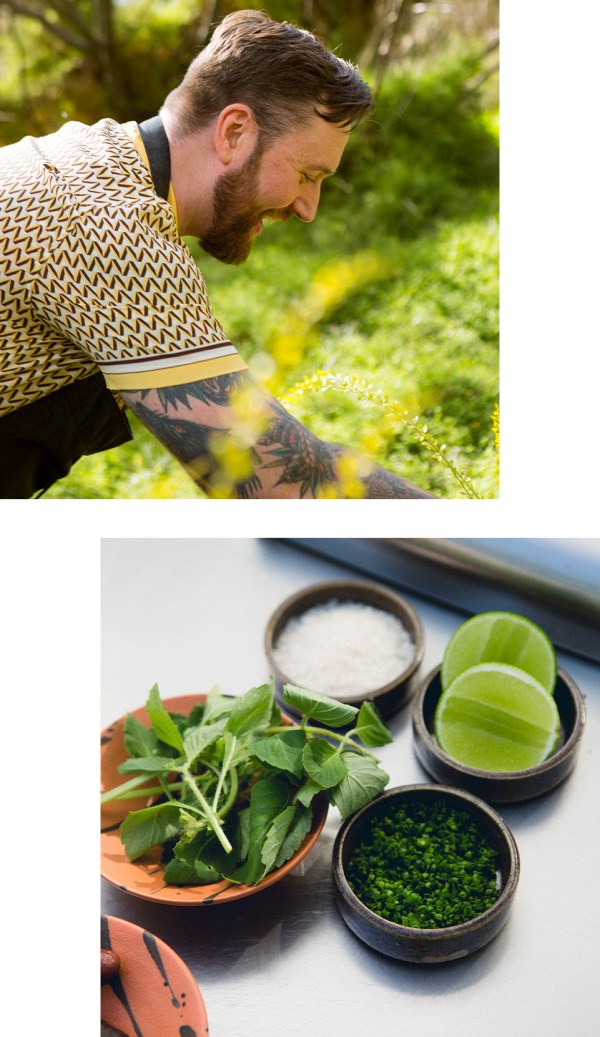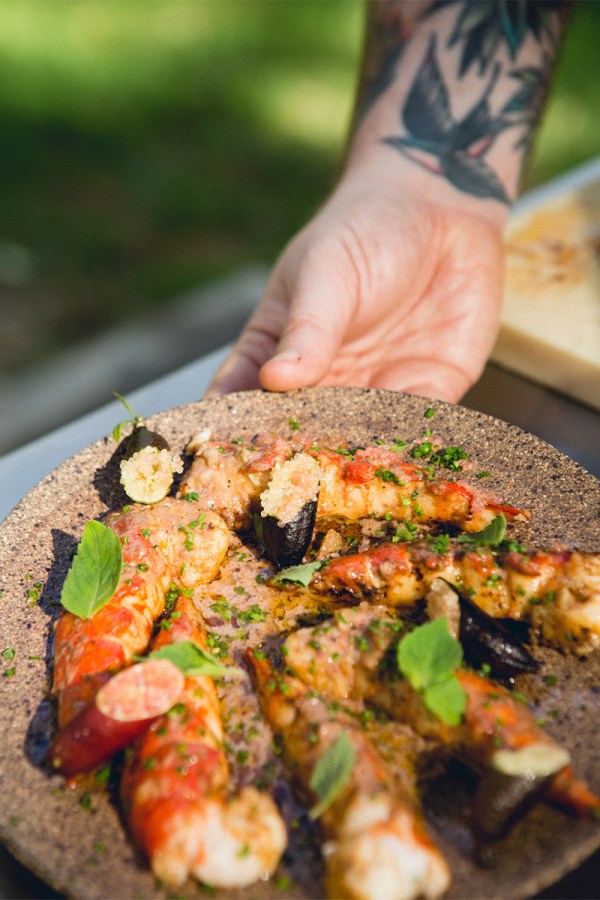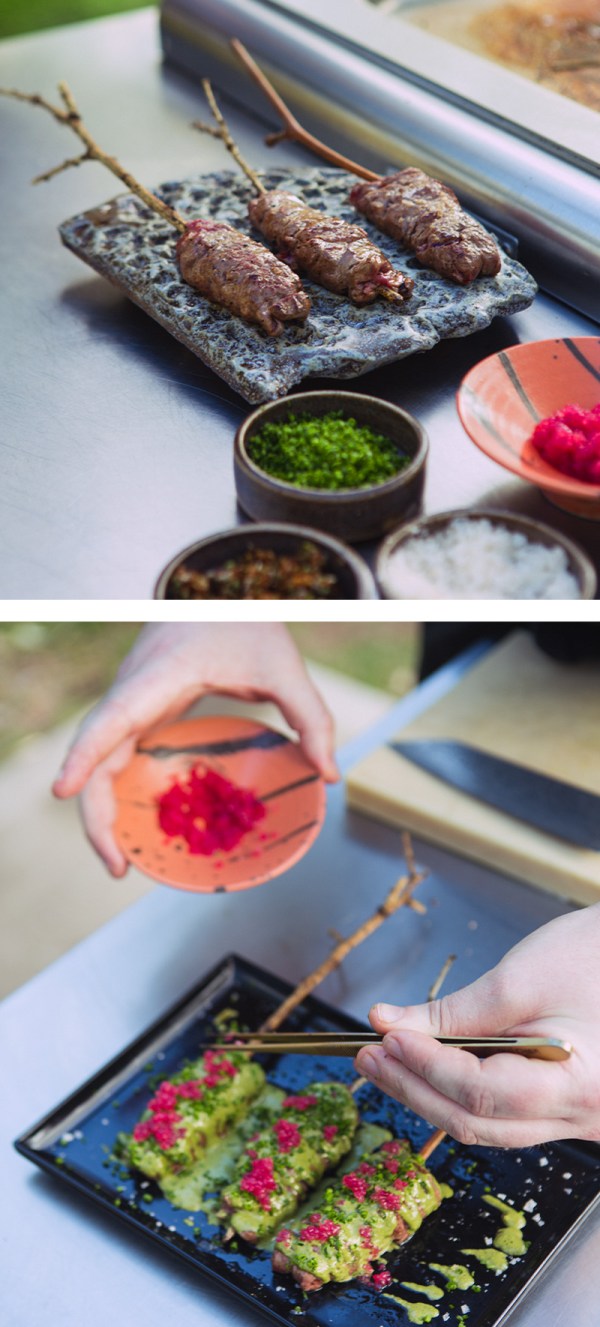Justin James vs. Public BBQ
Words: Lara Pacillo
Pictures: Nicholas Grange
For executive chef of award-winning Restaurant Botanic, Justin James, the key to fine dining is going back to our roots.
—
“Probably the best thing about the botanic gardens is that they are museums,” says Justin James. “They’re living and breathing museums of trees and flowers and everything in between. There are a lot of species in there that are pretty rare or ancient.”
To the executive chef of Restaurant Botanic, the Adelaide Botanic Gardens is also his pantry. Justin has exclusivity to forage within the economic division of the 51-hectare maze; we joined him to pick finger limes for our cook-up, just a few strides from the restaurant’s door.

Justin took over the venue in 2021 with a new fit out and refreshed fine-dining concept. The restaurant has since been awarded Restaurant of the Year by Gourmet Traveller, was given top marks by The Australian, named Best Restaurant in South Australia by delicious, and, most recently, was given three hats by Good Food Guide – one of the most prestigious culinary awards in the country.
Today, we’ve asked Justin to cook on a public barbecue in Warnpangga Bullrush Park, behind the Zoo.
Restaurant Botanic regularly sources around 50 items from the Botanic Gardens, with at least a few featured in every dish of its 26-course seasonal tasting menu.
Justin is preparing two of these dishes today, from a selection of garden produce and goods available at Something Wild in the Adelaide Central Market.
As he neatly lays out the ingredients, Justin talks through what he’ll be cooking: a kangaroo dish with finger lime, mountain pepper and green ants, and a marron dish accompanied with butter made with its brains.
Using as much of an animal as he can is common practice for Justin. Not only does it give you “bang for buck”, but after a two-year stint being vegan, he sees it as an act of respect.
“You appreciate that this was a living animal,” he says, motioning to the ants. “It might have feelings, it might not – I still want to treat it with respect, you know?”
If elements of an animal aren’t used in the cooking process, Justin will often include them as a part of a dish’s presentation. While it can be confronting, Justin says that’s the point. “As a chef, I have some responsibility to change people’s perception – what you eat and why you eat it,” he says.

The Michigan-born chef untucks tweezers from his apron to use throughout the cooking process. Some serious mise en place makes it a smooth journey from seasoning to grilling to plating up on custom ceramic plates Justin commissioned for Restaurant Botanic.
Seasoning is an important part of the process, but so too are the seasons. Justin’s garden-to-plate concept means he’s constantly working with what’s growing in the garden.
“That’s what we always used to do, we’ve just gone in a full circle,” he says. “Everyone used to have a garden. You grow what’s in season. To have the best tomato dish, you need the best tomato.”
Being attuned to the best local produce also means not flying things in from further afield and wasting freshness in transit.
“You want less miles travelled; the ingredients last longer, but also, it’s just better for the environment,” Justin says. “There are no cons, and there are all pros – there’s better flavour, you keep it in the local economy, all those bits and bobs.”
With our food plated up, Justin has a surprise for us. During lockdown, he became well-practiced in the art of cocktails.
He opens a plastic container holding three large, crystal-clear ice cubes – frozen and chainsawed in-house. He places them in small glass tumblers and shakes up a couple of chargrilled blood lime margaritas.
“You always have to have a drink,” he grins.
It’s light, it’s zesty, it’s tangy – a perfect pair to the green ants atop the kangaroo skewers and the finger lime pearls that grace both dishes.
“To me, this is what Australia tastes like,” Justin says. “The marron to me is the most luxurious ingredient in Australia. Same with the kangaroo – it’s just absolutely stunning.”
Walking back to the restaurant through the trees which arch overhead, past the bushes laden with produce, we begin to see what Justin sees. These gardens are exhibits. Cooking brings this history into a new context.
—

MARRON WITH CHARRED CREAM
Method
1. Remove tail from marron.
2. Skewer through natural cavity (do not pierce the flesh).
3. Take entrails out.
4. Blanch for 1 min for small marrons.
5. Ice bath and remove shell (do not damage flesh).
6. Skewer again, keeping the tail covered with a wet Chux or towel before serving (they will oxidise if not covered).

Charred Cream
Ingredients
—3g minced garlic
—1g black pepper
—10g lemon juice
—4g salt
—50g tempered butter
—50g marron coral
Method
1. Scrape the coral out from the marron head. In a mortar and pestle, begin to grind the garlic and salt to a paste.
2. Add the coral and tempered butter. Season with lemon juice and black pepper. Reserve until ready to grill the marron.
Serving
1. Cover the marrons with grapeseed oil and season heavy with salt. Grill the marrons over high heat starting with the top of the marron, then flip.
2. While the marron is cooking gently, warm the marron coral glaze, then brush on the marron while it cooks. Flip again and brush.
3. Once cooked to medium, remove the marron off the grill. Brush again with the coral glaze and squeeze lemon on top. Leave all of the marron to rest before slicing in half.
4. Place the marron on a plate. Spoon the marron coral over the marrons. Place fresh native basil leaves over the marron and finger limes cut in half.
5. Your guests can squeeze the finger lime over the marron while they eat.

KANGAROO WITH FINGER LIME, MOUNTAIN PEPPER AND GREEN ANTS
Method
1. Remove the meat. Clean any fat and sinew off the meat.
2. Marinate the kangaroo fillet in salt, grapeseed oil, and lemon for one hour.
3. Slice into one-inch blocks. Then slice thin on an angle.
4. Skewer 30g of meat onto a branch (or skewer). You should get 9—11 slices.
Spice mix
Ingredients
—10g Szechuan peppercorn
—10g coriander seeds
—10g lavender
—5g cumin

Method
1. Toast the seeds.
2. Pulse together.
3. Add the lavender. Mix all together.
Corriander paste
Ingredients
—5g spice mix
—15g grapeseed oil
Method
1. Grind the spice mix up in a mortar and pestle.
2. Add the oil.
Charred herb emulsion
Ingredients
—150 grape seed oil
—50g chive
—50g parsley
—50g coriander
—20g white balsamic vinegar
—15g shallot
—15g caper
—1g xanthan gum (to make it thicker)
Method
1. Pick and wash herbs. Grill each herb separately. The key is to create charr and also keep the herbs fresh.
2. Blend jus and vinegar together, add herbs, capers, shallots and xanthan gum.
3. Slowly emulsify oil in, season with salt and WB vinegar and taste.
4. Pass and chill over ice.
5. Put in piping bag.
Serving
—Chopped chives
—Finger lime cells
—Brown butter
—Roo skewer
—Coriander Paste
—Charred herb emulsion
—Green ants
1. Season the roo skewer before putting it on the grill over high heat.
2. Cook one side of the skewer for 1 minute. Rotate and then cook for another 45 seconds. For the next 45 seconds, brush with the spice glaze until it is all caramelised. Should be rare to medium rare.
3. Brush the skewer with brown butter, then brush with the spice mix paste.
4. Drizzle charred herb emulsion over the skewer.
5. Finish with chopped chives, finger lime, and green ants.
—
To help celebrate 10 years of CityMag, we’re going back through the archives and turning every Chef vs. Public BBQ feature into a cool lookin’ collectable recipe card. Download this one here.

